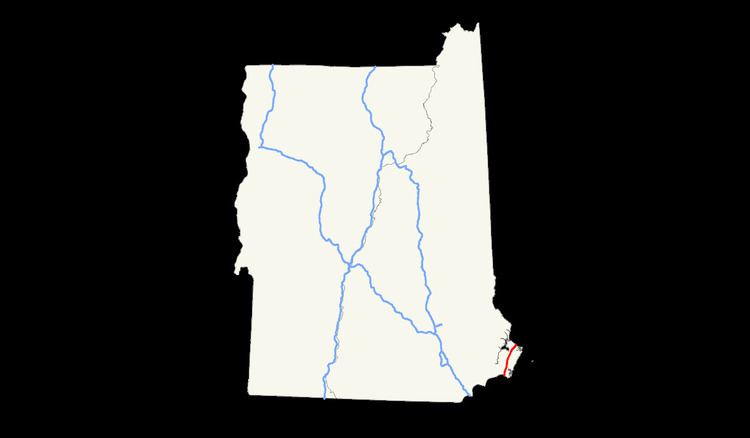Existed: 1957 – present North end: I‑95 in Kittery, ME Length 26.06 km | Counties: Rockingham Constructed 1957 | |
 | ||
County | ||
Interstate 95, the main Interstate Highway on the east coast of the United States, cuts through the Seacoast Region of New Hampshire. The majority of it, from the Massachusetts border to the Portsmouth Circle in Portsmouth, is the 14.29-mile-long (23.00 km) Blue Star Turnpike or New Hampshire Turnpike, a toll road maintained by the New Hampshire Department of Transportation Bureau of Turnpikes. The final piece in Portsmouth splits from the Turnpike south of the circle, running 2.42 miles (3.89 km) to the Piscataqua River Bridge, a steel arch bridge, towards Maine and the Maine Turnpike. In its short length through New Hampshire, Interstate 95 traverses six municipalities - Seabrook, Hampton Falls, Hampton, North Hampton, Greenland, and Portsmouth.
Contents
Map of Blue Star Turnpike, New Hampshire, USA
Route description
I-95 crosses from Massachusetts into New Hampshire in the town of Seabrook. There is a welcome center just north of the Massachusetts state line. The Seabrook Nuclear Power Plant is accessible via exit 1. The highway then continues through the coast towns of Hampton Falls and Hampton, with state-run liquor stores just prior to exit 2. I-95 interchanges with New Hampshire Route 101 (exit 2) in Hampton, then comes to the barrier toll booth soon after. That interchange also contains the only ramp toll used by all traffic passing between the Turnpike and Route 101. Traffic using the Turnpike that does not pass by or use exit 2 (in other words, anyone using exit 1 southward or exit 3 northward) does not pay a toll.
I-95 then continues through the towns of North Hampton and Greenland before entering the city of Portsmouth. Near the north end, a connection to the Portsmouth Circle provides access to U.S. Route 1 Bypass (US 1 Byp.) and the Spaulding Turnpike (US 4/NH Route 16). I-95 crosses into Maine less than 2 miles (3.2 km) from the Portsmouth Circle.
History
The turnpike opened in 1950 as a four-lane highway parallel to US 1 and was widened to eight lanes in 1976. The blue turnpike shield for the New Hampshire Turnpike is no longer in use, but was similar to the present-day signs for the Spaulding Turnpike and Everett Turnpike.
From its designation in 1957 until 1972, I-95 in Portsmouth did not connect to I-95 in Kittery, Maine. Instead, the expressway ended at the Portsmouth Circle. From there motorists had to use US 1 Bypass and go over the Sarah Mildred Long Bridge to the junction near the Kittery Circle with US 1. This bridge was what connected the New Hampshire and Maine Turnpikes. It is a drawbridge over the Piscataqua waterway, which would create an obvious problem. Not only would this be an obstacle to traffic, but the bridge was a narrow three-lane undivided roadway where the center lane could either be used in the direction of the greatest traffic flow or left closed for greater safety. Lane identification was accomplished via repeated banks of three traffic lights, one over each lane, and is the reason for the third (center) traffic light that is no longer used on the now two-lane bridge.
Furthermore, US 1 Bypass is not a controlled-access highway, but an all-access divided highway (similar to US 1 between Saugus and Boston in Massachusetts). As far as most motorists were concerned, I-95 ended at the Portsmouth Circle and restarted in Kittery. The Piscataqua River Bridge, which is not a drawbridge unlike the Long Bridge, was completed in the 1970s to correct this problem. Three construction workers fell to their deaths in the construction of the bridge.
Exit list
Exit numbers are sequential. The entire route is in Rockingham County.
